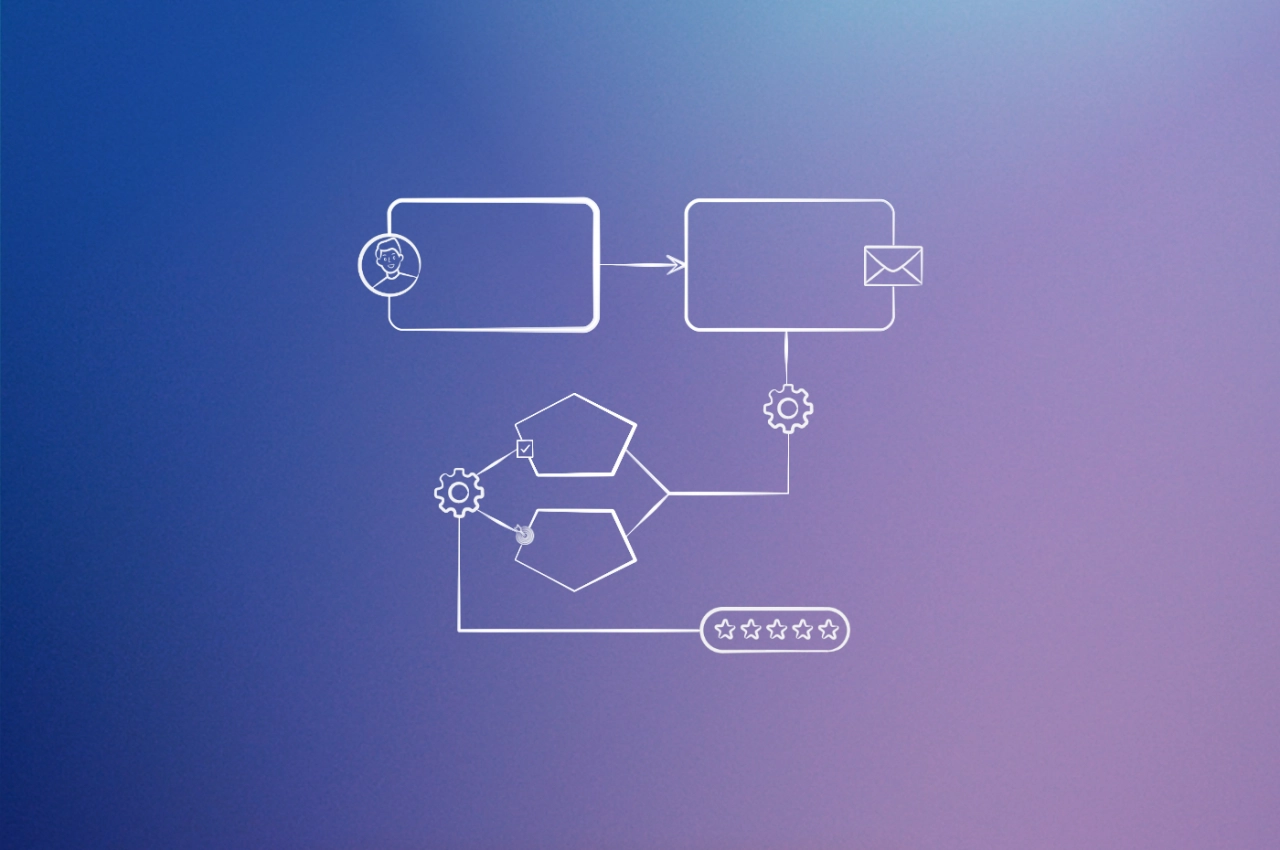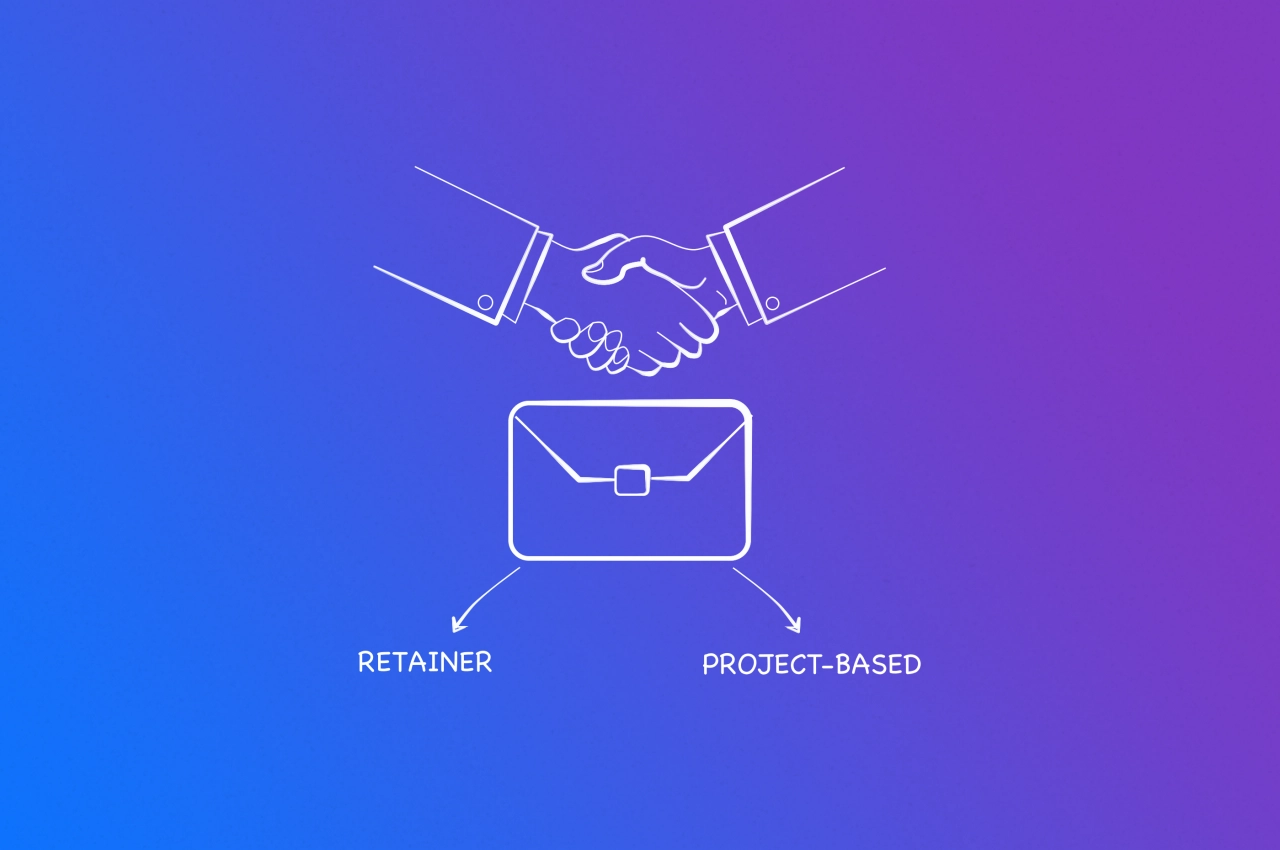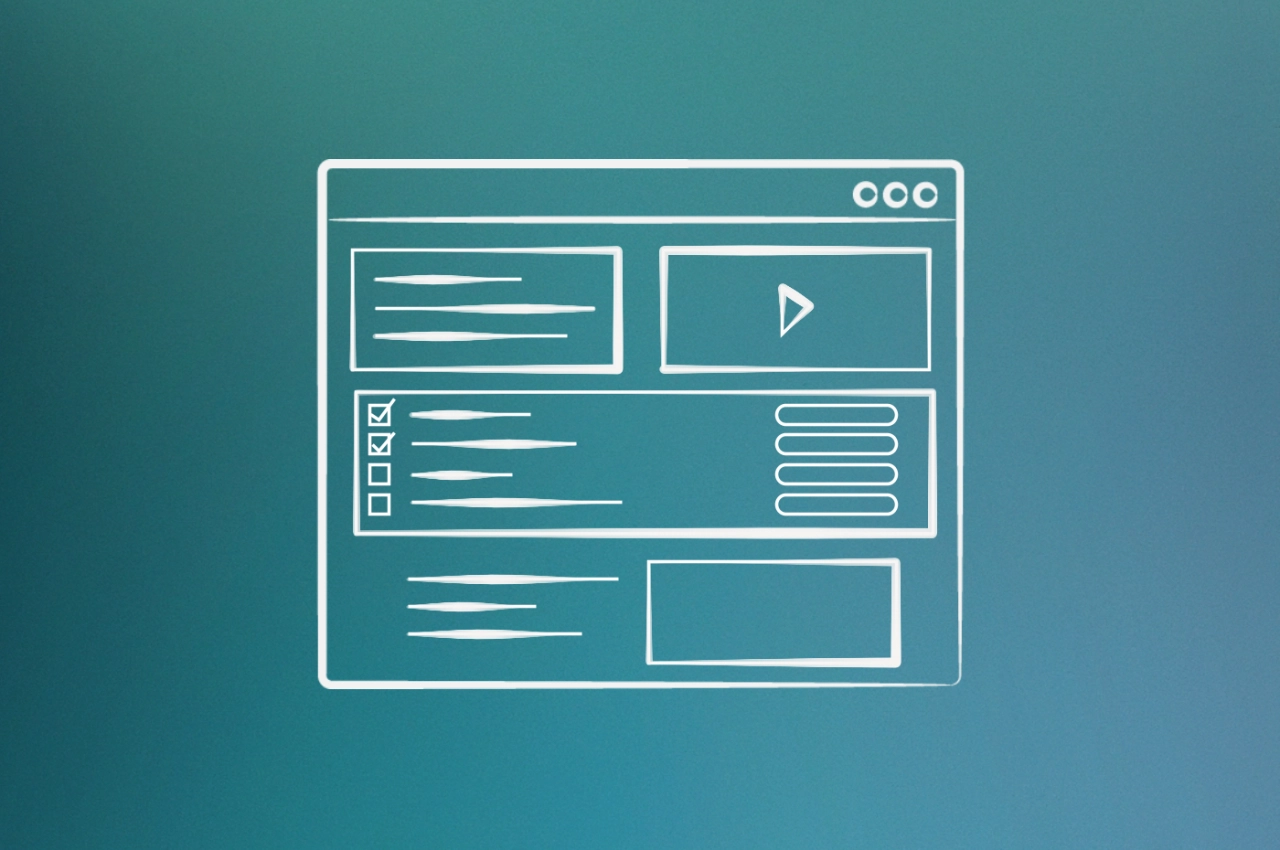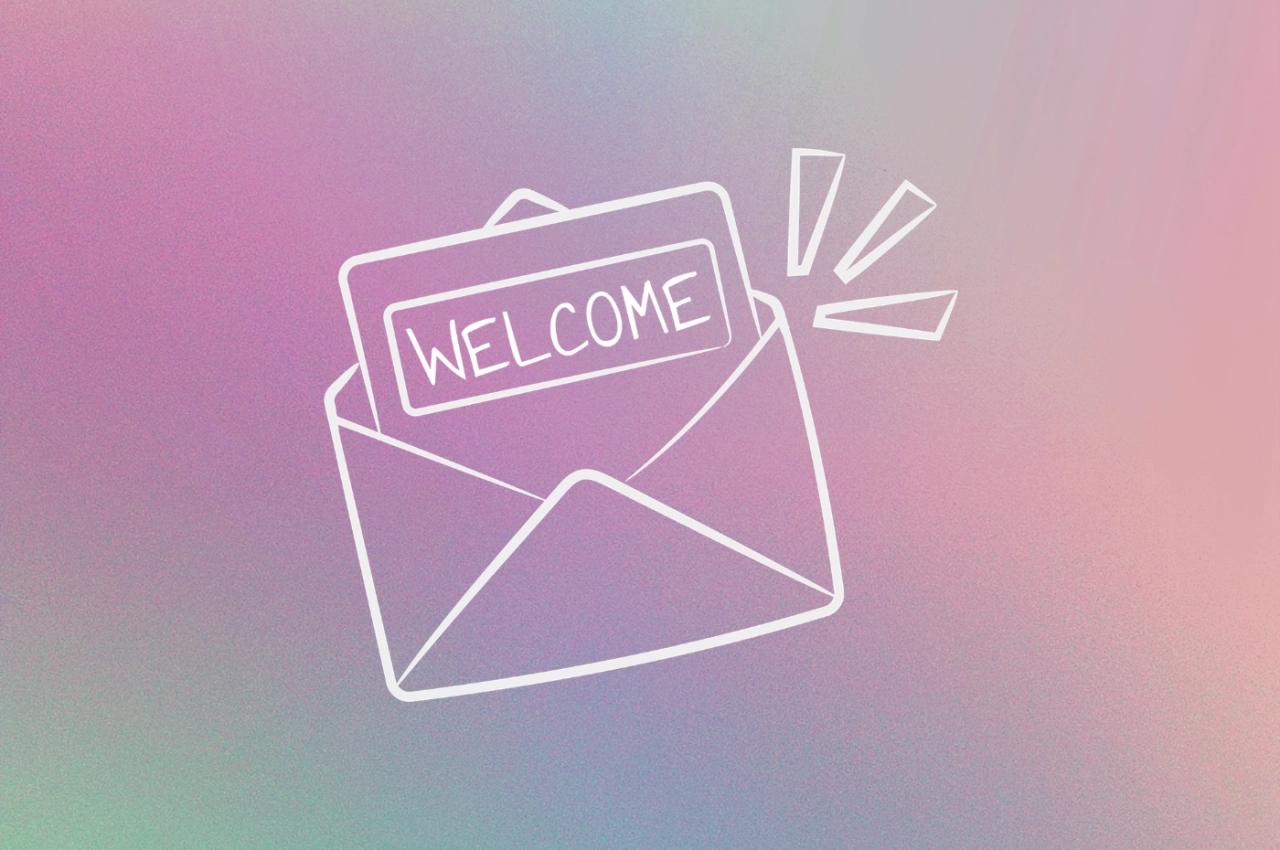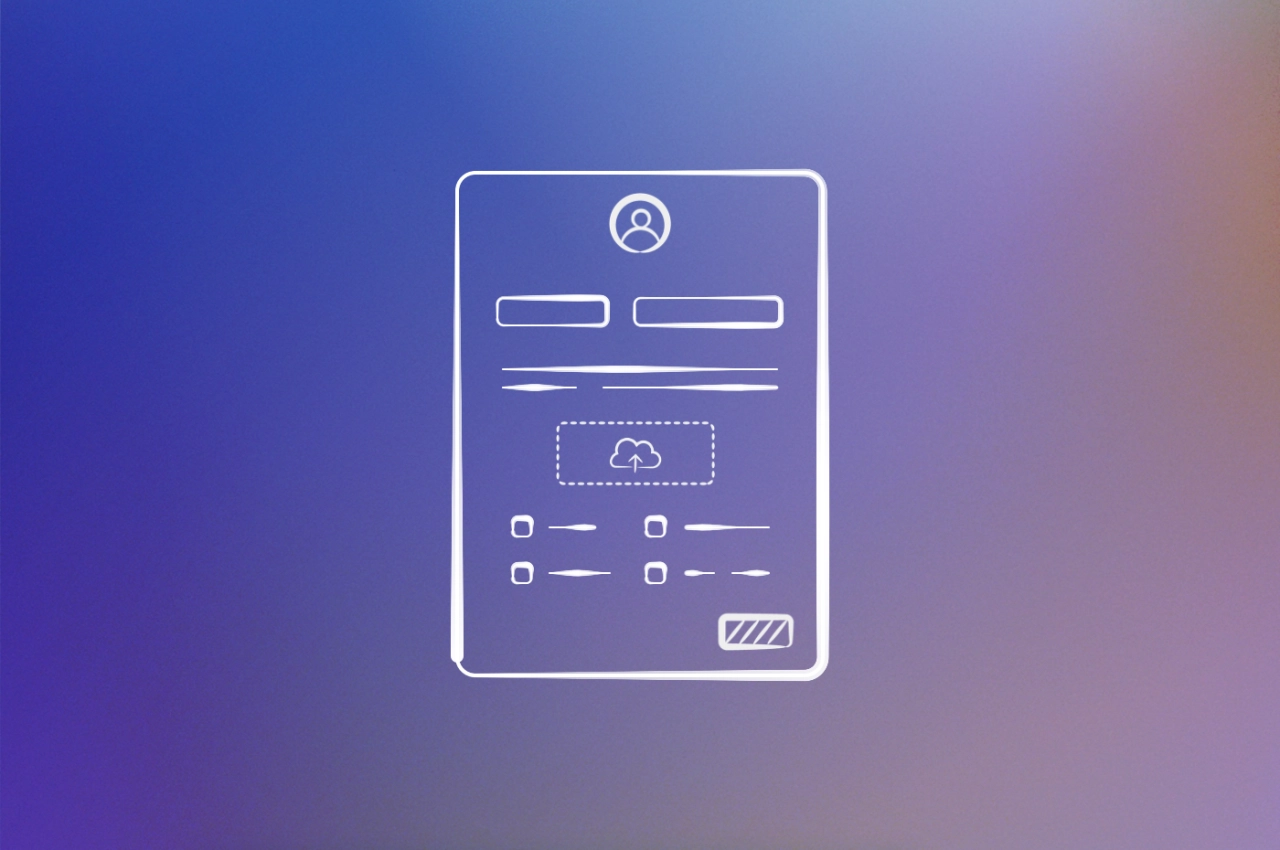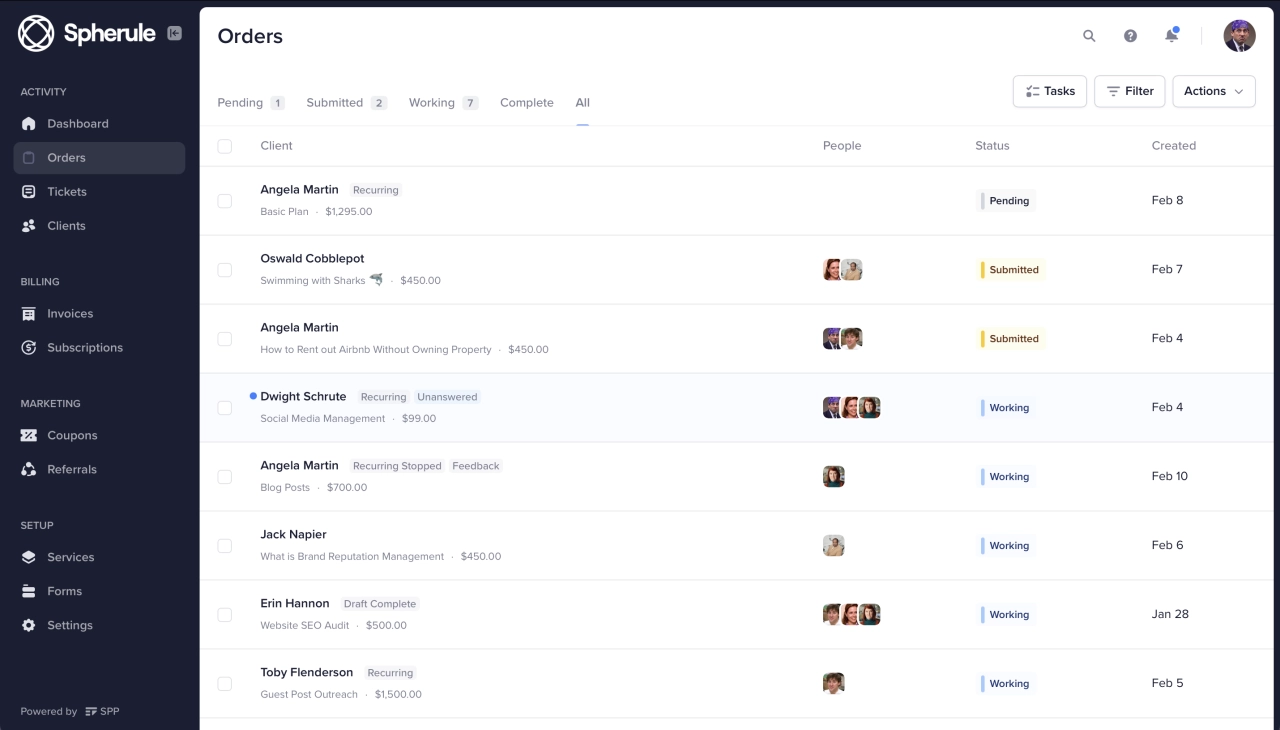- Automating customer onboarding ensures a consistent experience for all clients, reduces human error, and saves time by eliminating manual data entry and task management.
- Client onboarding automation can be accomplished by defining the client journey, using client portal software, and using automation tools like Zapier.
- Reviews and updates to the automated onboarding process help maintain personalized client engagements while optimizing efficiency and customer satisfaction.
If you’re running an agency and your agency client onboarding process feels like herding cats, you’re not alone. Here’s what's probably happening right now: a new client signs your proposal, you celebrate briefly, then reality hits. You’re scrambling to collect brand assets, waiting three days for their Google Ads login, and sending gentle reminder emails about that creative brief they promised to fill out.
If this sounds familiar, here’s one thing you might not realize: while you’re manually chasing down onboarding tasks, your team isn’t working on what actually drives results for clients. You’re stuck in administrative limbo instead of launching campaigns.
Imagine this instead: your new client signs the contract, immediately receives a personalized onboarding portal with clear next steps, and within 48 hours you have everything needed to kick off their first campaign. No back-and-forth emails; no delays; no stress.
The difference? A solid setup for your agency client onboarding automation. You can set this up in less time than it takes to onboard three clients manually. Let me show you exactly how to do it.
Why agencies need automated client onboarding
Here’s what’s happening at most marketing agencies right now: a new client signs your retainer, you’re excited to get started, but then reality hits. You’re waiting five days for their brand assets, two weeks for Google Ads access, and sending daily gentle reminder emails about that strategy questionnaire. Meanwhile, your team is burning billable hours on administrative tasks instead of launching campaigns.
If this sounds familiar, you’re not alone. According to AgencyAnalytics’ 2024 survey of 251 marketing agencies, nearly half of agencies struggle with allocating billable time effectively, largely due to manual onboarding processes.
When we automated our client onboarding process, it dropped our hands-on time from more than 5 hours to about 5 minutes.
 Franbeau Rhaz Beduya,
Agency Rocket Fuel
Franbeau Rhaz Beduya,
Agency Rocket Fuel
Here’s what manual onboarding is costing your marketing agency:
campaign launch delays waiting for brand assets and access credentials
wasted billable hours on data collection instead of strategic work
scope creep during onboarding when requirements aren't clearly captured upfront
inconsistent client experience depending on which account manager handles onboarding
team utilization problems with time lost to administrative tasks
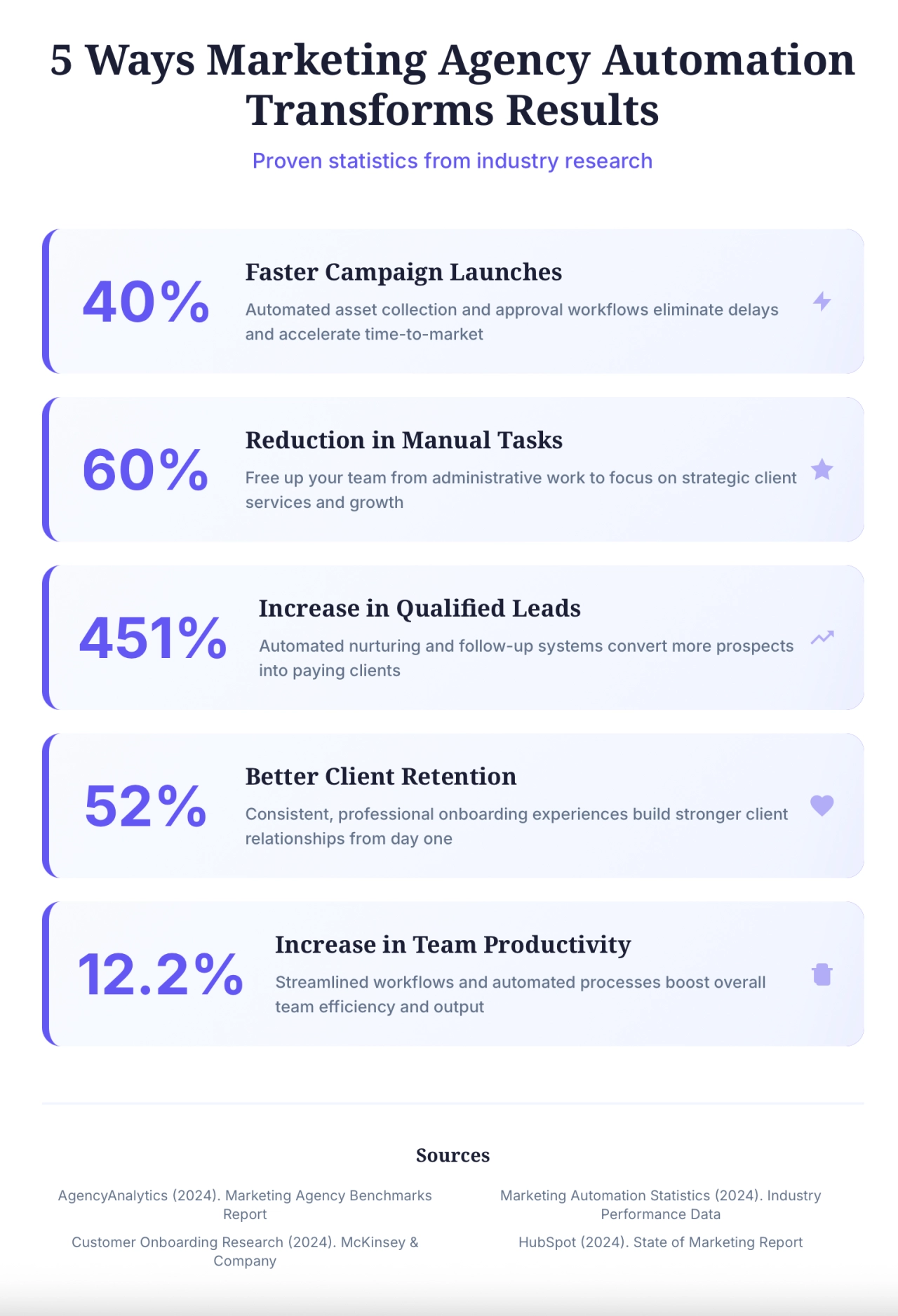
40% faster campaign launches
60% reduction in manual onboarding tasks
451% increase in qualified leads
52% better client retention
12.2% increase in team productivity
The research backs this up. Companies using marketing automation see dramatic improvements in efficiency, and the same applies to agency client onboarding. When you automate the manual tasks that bog down your team, you free up time for what actually drives results: strategy, creative work, and campaign optimization.
The question isn’t whether you can afford to automate your onboarding process. It’s whether you can afford not to.
Automating Client Onboarding: 5-Step Process
Now that you’re aware of why you should automate your onboarding process, let me show you how to do it.
1. Map your marketing agency’s client journey
Before you automate anything, you need to understand exactly where your onboarding process breaks down. Most marketing agencies lose weeks between the moment a client signs the contract and the first campaign goes live because of preventable delays.
Let’s analyze the three critical phases where marketing agencies typically struggle:
Campaign readiness assessment
What’s happening right now: Your new PPC client signs the contract on Monday, you celebrate Tuesday, then spend the next 10 days chasing down their Google Ads access, brand assets, and campaign goals while your team sits idle.
These are the main pain points you’re dealing with:
Platform access delays: Waiting 5–7 days for Google Ads, Facebook Business Manager, or analytics account access
Brand asset chaos: “We’ll send the logo tomorrow” turns into two weeks of back-and-forth for the wrong file formats
Strategy gaps: Clients think they want more traffic but haven’t defined target audience, budget allocation, or success metrics
Handoff confusion: Sales promised one thing, account manager discovers something completely different
Project kickoff bottlenecks
The hidden time killers you are not paying attention to:
Scope creep starts here: Client mentions “oh, and we also need help with our Google Business Profile” after signing a PPC-only contract
Missing prerequisites: Can’t launch Facebook ads because their pixel isn’t installed, business verification is pending, or their website lacks conversion tracking
Content delays: SEO client needs blog content but hasn’t provided target keywords, competitor insights, or brand voice guidelines
Team confusion: Which account manager handles what? Who’s responsible for creative approvals? When are check-ins scheduled?
Early warning signs system
Keep an eye on these red flags that predict project delays:
client takes more than 48 hours to respond to asset requests
they ask “what do you need from us?” after signing (scope wasn’t clear)
multiple stakeholders emerge who weren’t involved in sales conversations
technical requirements weren’t assessed (website speed, tracking setup, etc.)
Here’s what successful agencies do differently: They map out every single touchpoint from contract signature to first campaign launch, identify the top 5 delay points, and build automation around those specific bottlenecks.

Your homework: Document your last 5 client onboardings using the above audit.
2. Define roles and handoff process
Most marketing agencies don’t have dedicated onboarding teams. You’ve got 5–15 people wearing multiple hats, and your customer success manager is probably also handling account management, project coordination, and client communication.
Here’s what actually works for marketing agencies.
The sales-to-delivery handoff
This is where 60% of onboarding problems start. Your salesperson promised “we’ll have your Facebook ads running next week” but forgot to mention the client needs business verification, which takes 3–5 business days.
Essential handoff documentation:
what was actually sold (not what the client thinks they bought)
Ttmeline promises made during sales calls
technical prerequisites discovered (or missed) during discovery
special requests or customizations mentioned in passing
client’s internal approval process and key stakeholders
SPP tip: Use the client notes section to document handoff details. Create a standard template so nothing falls through the cracks.
Service-specific ownership
Here’s how you can stop the “who's handling this?” confusion:
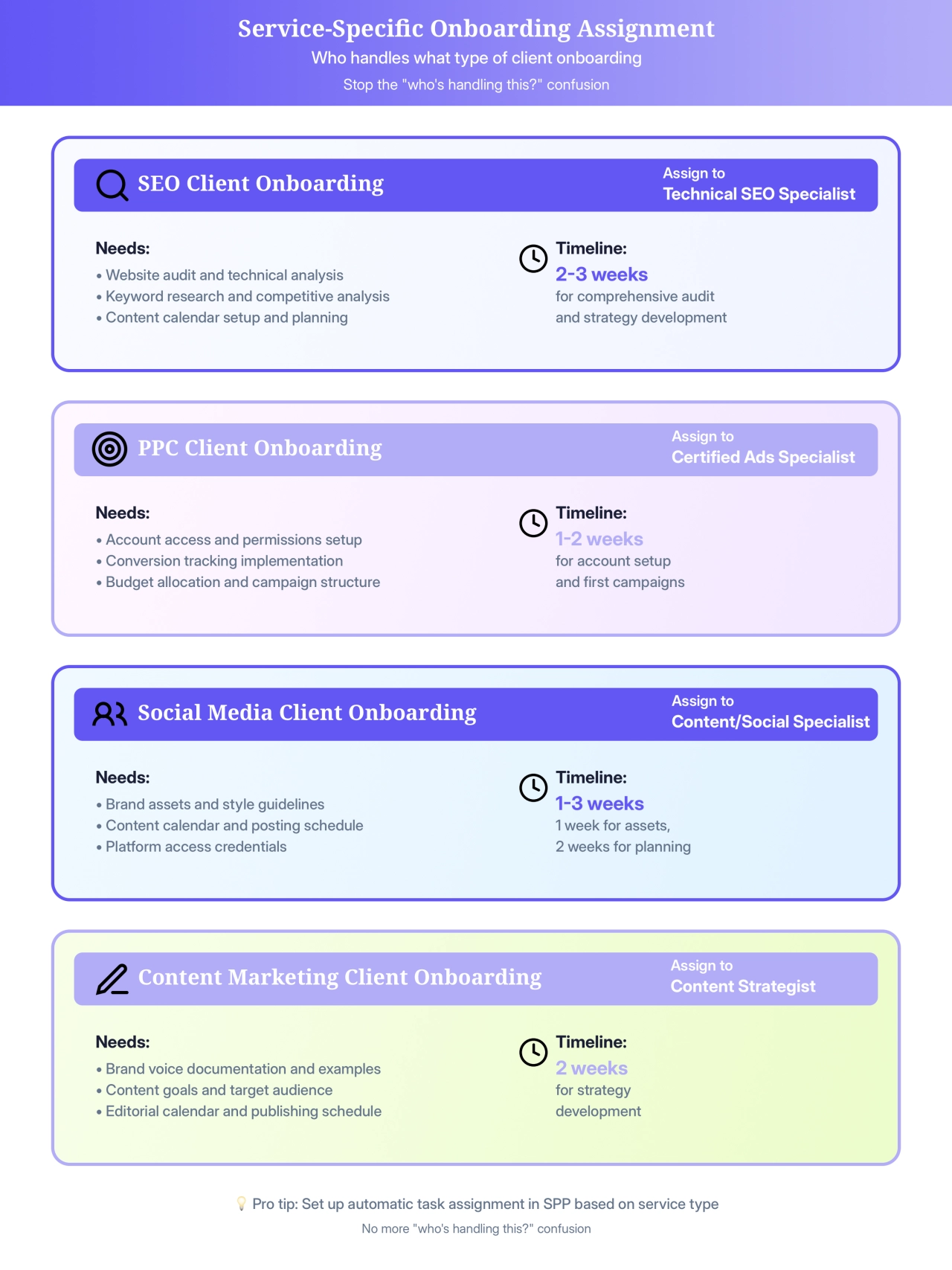
Internal accountability system
You don’t want clients to fall through the cracks, so implement this system:
Day 1: Account manager receives handoff, sends welcome email with next steps
Day 3: Follow up if asset requests haven't been completed
Day 7: Internal check-in - are we on track for promised timeline?
Day 14: Escalate to agency owner if major blockers persist
SPP automation: Set up task templates for each service type. When a client makes a purchase, the checklist is created with assigned team members and due dates.
The small agency solution
If you’re running a very small agency with a few people, create time blocks for onboarding work:
Monday mornings: New client welcome calls and asset requests
Wednesday afternoons: Follow up on pending items and troubleshoot blockers
Friday afternoons: Review progress and plan next week's onboarding tasks
You don’t need a team, you need a system. Whether it’s one person or five people, everyone should know exactly what happens when, who’s responsible, and what the client expectations are.
Your action step: Document who in your agency handles what type of onboarding, create handoff templates, and set up automatic task assignment in SPP based on service type.
3. Replace email chaos with a client onboarding tool
I see this problem all the time with agencies: you’re managing client onboarding through email threads, shared Google Drives, and “can you send that again?” requests. Your clients feel confused, important files get lost, and you look less professional than you are.
Instead, you could give every client a branded portal where they can:
see exactly what’s needed for onboarding
upload assets and access credentials in organized folders
track progress on campaign setup
communicate with your team in one centralized place
This matters matters for marketing agencies because:
SEO clients get a hub for website audits, keyword research, and content calendars
PPC clients can securely share account access and track campaign setup progress
Social media clients upload brand assets and approve content in organized workflows
Instead of 15 different emails, your client logs into their branded portal and sees: “Welcome! Here are your 3 next steps to get your campaigns launched.”
Your action step: Stop using email and shared drives for client onboarding. Choose client onboarding software that keeps everything organized in one branded location.
4. Automate the repetitive tasks that kill productivity
Before diving into specific onboarding automations, it’s helpful to understand marketing automation principles that successful agencies apply to their client processes. The core principle is simple: automate repetitive tasks so your team can focus on high-value work.
Here’s the time waster you’re probably facing: Your team spends 15+ hours per client on manual tasks that could be automated: sending welcome emails, creating project folders, assigning team members, setting up recurring check-ins, and chasing down incomplete onboarding forms.
Automation should only be introduced if it will enhance the customer’s onboarding journey in terms of speed, ease or value realization. To achieve that, it requires a business to align across many functions (product, marketing, services) to ensure that automation is seamlessly integrated into the business’s product and service experiences.
 Sherry Ng,
Ex-HubSpot
Sherry Ng,
Ex-HubSpot
Here’s what your agencie can easily automate:
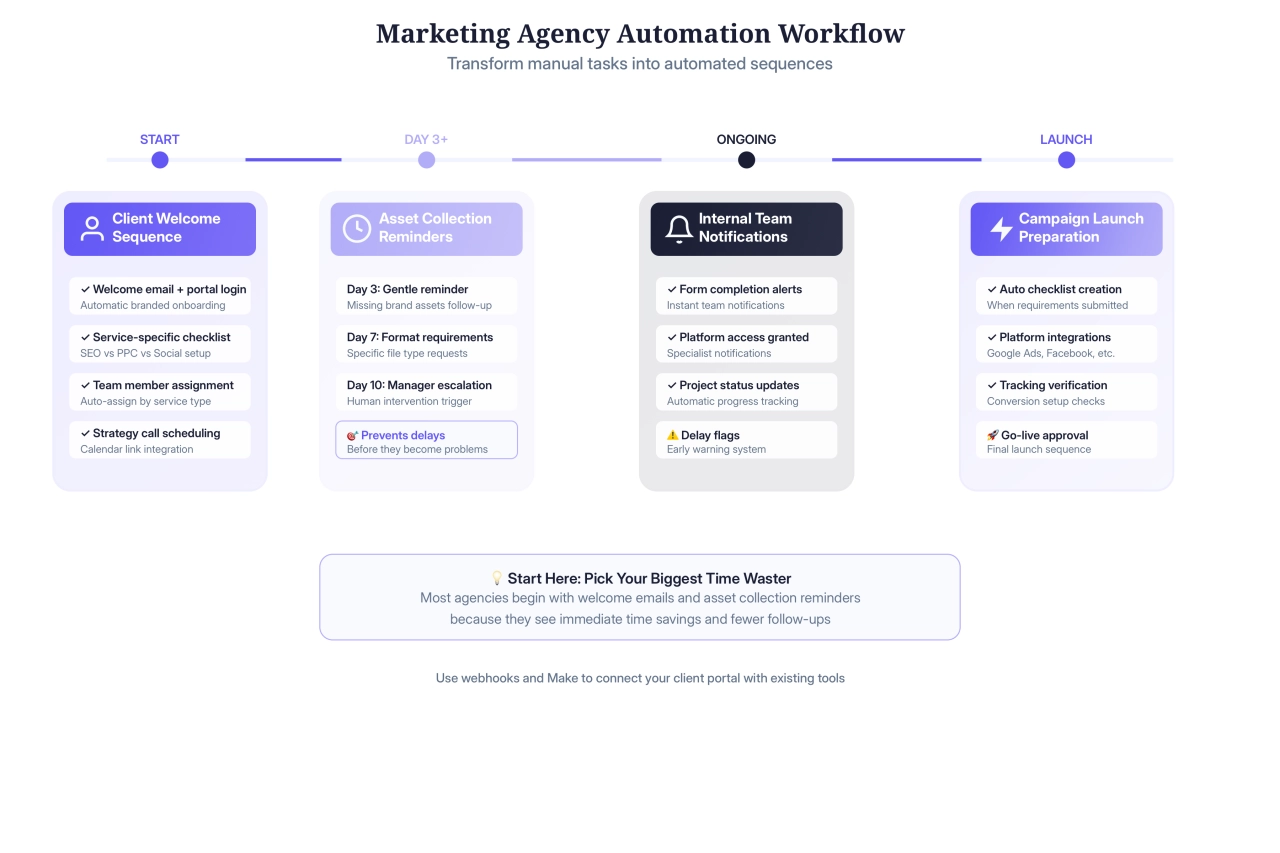
Pick your biggest time waster from client onboarding and automate it first. Most agencies start with automatic welcome emails and asset collection reminders because they see immediate time savings.
SPP integration tip: Use webhooks and Zapier automations to connect your client portal with your existing tools. When a form is submitted, automatically update your project management system and notify the right team members.
5. Track performance and optimize your process
The mistake: Most agencies set up automation once and forget about it. Six months later, they're still losing clients during onboarding and don't know why.
Successful agencies track the following metrics:
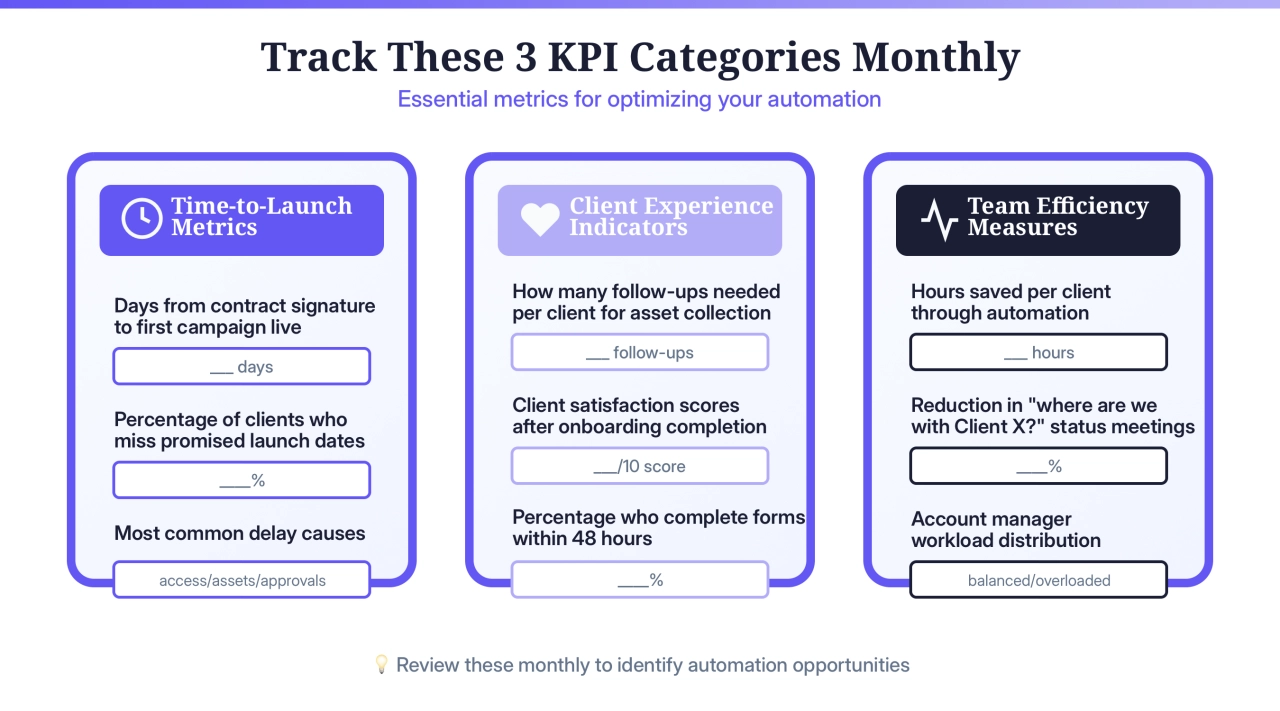
If you want to stay consistent, optimize every week like this:
Week 1: Review last month's onboarding data using your tracking worksheet
Week 2: Survey 3 recently onboarded clients about their experience
Week 3: Ask your team which manual tasks still frustrate them
Week 4: Implement one improvement based on the data
Red flags that need immediate attention:
same delay cause appearing 3+ times in your audit
client complaints about confusing onboarding process
team members still spending 10+ hours per client on manual tasks
clients taking longer than 2 weeks to provide basic requirements
Set a monthly calendar reminder to review your onboarding metrics. Track the same 3 KPIs consistently: average days to launch, client satisfaction score, and hours saved through automation.
Looking to make sure SPP.co is right for you? Get on a call with our customer success team.
Tip: Use a tool like Zuko to track form completion rates and identify where clients get stuck in your onboarding process.
Frequently asked questions
How long does it take to set up automation for an agency?
Most agencies have basic automation running within 2–3 weeks. Start with welcome emails and asset collection reminders first, then add more advanced workflows monthly. Hire an expert if you want to implement SPP quickly.
Can this work for small agencies?
Small agencies (2–5 people) see excellent results because automation prevents the chaos of rapid growth. When you’re scaling from 5 to 15 clients, manual onboarding breaks down fast. Automation ensures nothing falls through the cracks during team handoffs and lets you maintain quality as you grow.
What if my clients refuse to use the portal and only want email?
About half of clients will stick with email initially, which is fine. If you use SPP, clients can continue email communication with you. The key is making the portal optional but obviously more convenient than email back-and-forth.
What’s the realistic investment to get automation working properly?
Expect to invest 20–30 hours upfront to set up your core automation workflows, then 2–3 hours monthly for optimization. Most agencies break even on this time investment after onboarding 3–4 clients with the new system.
What happens when automation fails or clients need something custom?
Build manual override options into every automated workflow. When clients have special requirements, your system should flag them for human review while still processing the standard onboarding items automatically. Never automate 100% of any process.
How do I integrate automation with our existing tools and systems?
Most agencies already use 3–5 core tools (CRM, project management, email, accounting). The key is starting with your most-used tool as the hub and connecting others through platforms like Zapier or Make. Begin with simple 2-app connections before building complex multi-tool workflows.
How do I measure if our automation is actually saving time and money?
Track three key metrics monthly: average onboarding completion time (from contract to first deliverable), team hours spent per client onboarding, and client satisfaction scores.
How can we automate the customer data onboarding process to reduce manual work?
Use automation tools like Zapier or Make.com to connect your CRM, project management software, and communication tools. Automate welcome email sequences, task creation, calendar scheduling, and document collection. Set up triggers for contract signing to automatically create client folders, assign team members, and send intake forms.
Automate your client onboarding today
If you’re still contemplating how to automate your customer onboarding process, this blog post has hopefully given you not only inspiration, but actionable tips to get started right away. Running any sort of agency requires you to make the most out of your time, cut down on manual tasks, and make the experience for your clients as good as you can.
Automating manual onboarding tasks allows your team to focus on more important things that require their full attention. And you can service customers faster and more efficiently.
